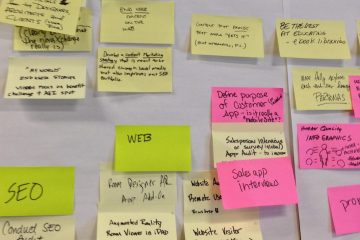Project Planning Essentials
This is the year you finally re-design your website. It’s long overdue, and while everyone from the CEO to the help desk agrees your company needs a new site, it falls to you to make it happen. A website re-design is a high-profile investment that requires extensive resources and planning. One blog post can’t tell you everything, but it can help you start off right.
How to focus and develop a project plan.
To help you prioritize and focus, this overview highlights some key elements to include as part of your website design project plan.
1. Establish and define the unified vision.
What is the fundamental purpose of your company’s website and the vision for improving it? This seems easy, but articulating a concise statement all decision-makers agree on is usually challenging. Is the focus selling products and pushing online quotes OR conveying thought leadership and providing insightful content? The first thing you must do is have documented agreement on the vision for the site the company wants to build.
2. Identify key stakeholders and gather their input early.
A website’s company-wide visibility can make the project politically charged and challenging internally. Include the right critical people from the start. Whether it’s online surveys, interviews, group discussions or workshops, use whatever the best research method is for your organization to gather input now and avoid disappointment and scope creep later. Ask stakeholders about the current site, what would help improve business or efficiency, and how they define success.
3. Develop measurable objectives and goals.
Your current website is out of date, unusable on mobile devices and hard to maintain. You want to improve user experience and make the site easier to use. While these are all valid drivers for a new website, they are also vastly generic statements that aren’t quantifiable. Unless you specifically define goals now, with measureable outcomes, you won’t be able to quantify success later.
4. Focus on your primary target audiences and their goals.
Your sales force thinks every prospect and industry is essential and has to be addressed on the home page in 20 languages. Try to design for every persona (and internal opinion), and you will successfully design for no one. Identity the key target audiences, why they would visit the site and the tasks these users want and need to complete.
5. Clearly define the scope and requirements.
Failure to clearly define requirements up front or constantly changing requirements is why most software projects fail . Requirements are functions and capabilities the website must have and do. They define the needs of the business and the user, and can be technical, process or design oriented. While a requirement may begin as a simple statement (e.g., “users must be able to save documentation”), it must be detailed as the project progresses. One statement can lead to more questions, additional features and scope creep if you don’t document exactly what is being done.
6. Establish a team and agree on a project plan.
Before you can outline project management details, everyone needs to agree on who is doing what and how. Define the team roles, responsibilities, communication process, resources, scope and timing along with assumptions and dependencies. The team will need to revisit things as the project evolves, but everyone needs a baseline from which to start.
7. Keep it simple. Decide, document and move on.
Everything will change. You can’t avoid it. Just make decisions, document and communicate what’s happening, and keep working. A website is never done, so better to do something and improve it later than to be paralyzed waiting for the perfect situation that never comes.
Your website isn’t just a marketing project. It’s a critical business tool, a reflection of your company’s brand and part of your customers’ experience. Successful project planning can help make it great.

